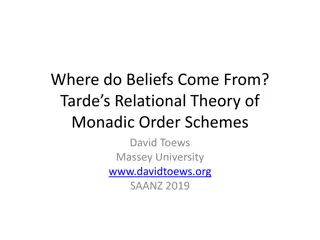A Brief History and Beliefs of Anglicanism
Anglicanism traces its origins to the early spread of Christianity in England, with notable events including King Henry VIII's break from Rome, the development of the Book of Common Prayer, and mission work expanding globally. Anglicans emphasize indigenization in ministry and have translated their liturgy into numerous languages to reach diverse cultures.
Download Presentation

Please find below an Image/Link to download the presentation.
The content on the website is provided AS IS for your information and personal use only. It may not be sold, licensed, or shared on other websites without obtaining consent from the author.If you encounter any issues during the download, it is possible that the publisher has removed the file from their server.
You are allowed to download the files provided on this website for personal or commercial use, subject to the condition that they are used lawfully. All files are the property of their respective owners.
The content on the website is provided AS IS for your information and personal use only. It may not be sold, licensed, or shared on other websites without obtaining consent from the author.
E N D
Presentation Transcript
Being Anglican Who are we and what do we believe?
When did the Anglican Church come into existence? With King Henry the VIII?
Before Henry... Lollardy Renaissance Humanism
During Henrys reign: Broke from Rome/Henry named Supreme Head of the Church in England Thomas Cranmer English Bible (The Great Bible) Aligned with German princes
King Edward VI...1547-1552 1549 Prayer Book 1552 Prayer Book Accomplishing what? Stripping away... Worship in the vernacular Communion in both kinds
Elizabeth I said that she and her people followed no novel and strange religions, but that very religion which is ordained by Christ, sanctioned by the primitive and Catholic Church and approved by the consentient mind and voice of the most early Fathers. So...when did the Anglican Church come into existence? When Christianity first made its way into England.
What IS Anglicanism? Mid 1500 s in the 1600 s... *Church of England *English colonists/colonies *Slaves *Indigenous friends and allies
Before long, things changed... 1700 s Scope of mission widened missionaries began to seek out those who were not English and did not live in or near an English colony. Philip Quaque ordained in 1765 50 years of ministry along West Coast of Africa 1800 s: Voluntary missionary societies were formed and the gospel was being spread all over the world
Characteristic emphases of Anglican missionary activity... 1. there has been a stress on indigenization in terms of planting the Church and drawing out an indigenous ministry 2. Strong emphasis on learning missionaries and converts The two emphases together naturally led to both the Bible and the Anglican liturgy being translated into many different languages.
Within just a couple hundred years of Henrys break from Rome, to be of the Church of England didn t necessarily mean you were from England, in England, in English colonies of even English at all BUT... You were still Anglican so... There must be more to it than simply being the Church of England.
Anglicanism... Faith Doctrine Practice Order Spirit Worship of the churches of the Anglican Communion.
Our View of Authority Scripture Tradition Reason
Anglican Ethos Via Media Vocation Liturgy
Via Media Way of thinking Middle Way Compromise...but not simply compromise
Anglicanism Via Media Puritans...................................Roman Catholic Church Both Reformed.............and...............Catholic Embraced everyone that it could: Low Church.........Broad Church.........High Church Evangelical Liberal Anglo-Catholic protestant scholarly catholic
Anglican Vocation The way we take our faith and knowledge of our faith into the world and live it. Love our Truth Quest for Unity To Proclaim the Gospel of Christ
Our Liturgy Supplication/Praise Worship Theological experimentation/formulation Lex Orandi Lex Credendi The Law of Praying is the Law of Belief
Thomas Cranmer Priest and Pastor Administrator and Politician Liturgiologist *early Christian Fathers *parts of the Roman medieval rite Sources *Eastern liturgies *Lutheran
What was crafted was used experimentally in certain major parishes in England FIRST.... ...theological and popular reaction was taken into account... ...THEN the 1549 prayer book was finalized and distributed. This same process prevailed in other churches within the Anglican Communion as they have produced their own prayer books.
Theology formulated in: 1. The selection/arrangement/composition of the prayers 2. In the rubrics state the permissible variations 3. Lectionary what Scripture is appropriate (some latitude given)
Prayer Book embodies the Via Media Essentially a contract between Church and People...like the Magna Carta, it was never meant to be unchanging. Remember the Anglican love of truth and quest for knowledge Scripture and worship is to accessible by being in their own language (vernacular)
Sometimes changes are necessary to stay true to reformation principles... Vernacular Language Theological Prevent us, o Lord, in all our doings with thy most gracious favour... We believe in the Holy Spirit who proceeds from the Father and the Son... BCP p.71 BCP p.87
Changes in Societal Context The Rite of Baptism Placement Composition
Strengths of Lex Orandi Lex Credendi within Anglicanism 1. Strong sense of tradition, continuity, and order 2. High ecclesiology the Church holds in trust the Common Prayer on which order is centred. 3. High anthropology the way is left open for a variety of forms of personal piety and theology as long as there is no open conflict with the Common Prayer.
4. Guards against idolizing the past or jumping quickly into something new. 5. Anglicanism leans towards a critical yet positive orientation to human culture. Is there a downside? Lex Orandi tends to prevail over Lex Credendi
Symbol vs. Sign Symbol gives rise to thought. (Paul Ricoeur b. 1913) We live in the sacred. Symbol We don t find symbols, they find us. Multi-dimensional, endless
For us, we see the givenness of the sacred first and most fully in the symbols and narratives of Jesus life, death, and resurrection... These symbols and narratives are enacted ritually, prayed, chanted, heard, and sung... They are the icons of our faith and we remember them through the activity of the Holy Spirit in our Church. Symbol and narrative live within Scripture...
Other symbol and narrative... The Lord be with you... COMMON prayer Our postures We, ourselves The Cross Our prayer pattern The Peace... peace The Gospel Procession The Preparation of the Gifts Eucharistic Prayer The Eucharist The Dismissal























